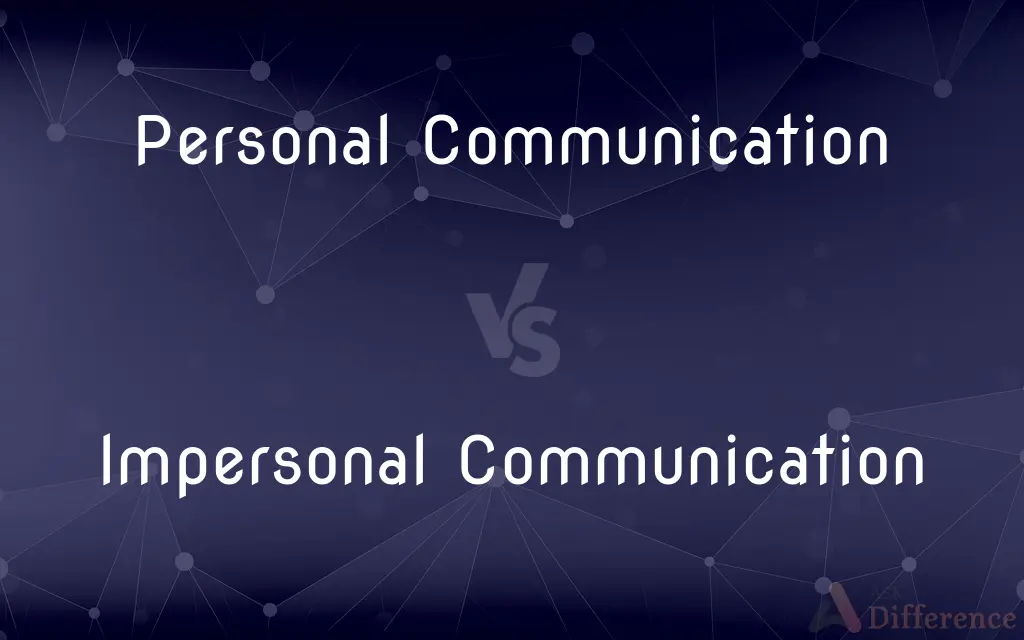Personal Communication vs. Impersonal Communication — What's the Difference?
Edited by Tayyaba Rehman — By Fiza Rafique — Published on November 15, 2023
Personal Communication involves direct, intimate interactions, often expressing emotions or personal opinions. In contrast, Impersonal Communication is more formal, detached, and lacks personal feelings or emotions.

Difference Between Personal Communication and Impersonal Communication
Table of Contents
ADVERTISEMENT
Key Differences
Personal Communication is intimate and comes with a depth of emotion and familiarity. Impersonal Communication, meanwhile, is characterized by detachment, neutrality, and the absence of emotional involvement.
Personal Communication frequently occurs among friends, family, or close acquaintances, where the exchange is emotionally charged or familiar. In contrast, Impersonal Communication often takes place in formal settings or among strangers, emphasizing information over emotion.
While Personal Communication aims to build or maintain relationships, share feelings, or express personal opinions, Impersonal Communication is typically used to convey factual information without emotional context.
Personal Communication generally involves immediate feedback, allowing for real-time adjustments based on the receiver's reactions. Impersonal Communication, on the other hand, might not provide immediate feedback, as it's often one-way, like a public announcement.
Personal Communication often uses informal channels like casual chats, text messages, or personal emails. Impersonal Communication usually employs formal channels such as official reports, mass media broadcasts, or institutional announcements.
ADVERTISEMENT
Comparison Chart
Nature
Intimate and emotional.
Detached and neutral.
Context
Among friends, family, or close acquaintances.
In formal settings or among strangers.
Purpose
Build or maintain relationships; express personal opinions.
Convey factual information without emotional context.
Feedback
Immediate and interactive.
Might not be immediate; often one-way.
Channels
Casual chats, text messages, personal emails.
Official reports, mass media, institutional announcements.
Compare with Definitions
Personal Communication
Direct communication involving personal feelings or opinions.
Through personal communication, they resolved their misunderstandings.
Impersonal Communication
Neutral communication that avoids personal feelings or biases.
News broadcasts aim for impersonal communication to ensure objectivity.
Personal Communication
Expressive communication emphasizing individual feelings and emotions.
He valued personal communication as a way to truly get to know someone.
Impersonal Communication
Communication that's formal and lacks emotional involvement.
Corporate emails are a classic form of impersonal communication.
Personal Communication
Informal communication often among acquaintances.
Personal communication at the family reunion made everyone feel connected.
Impersonal Communication
One-way communication with limited feedback or emotional exchange.
Reading a user manual involves impersonal communication.
Personal Communication
A way to build or maintain relationships through direct interaction.
Personal communication is essential for long-distance relationships to thrive.
Impersonal Communication
Detached interaction focusing on facts or data.
Scientific reports rely on impersonal communication to present findings.
Personal Communication
Interaction characterized by intimacy and emotional depth.
Their late-night conversations were filled with personal communication about their dreams and fears.
Impersonal Communication
Communication typically among strangers or in official settings.
Announcements in train stations are a type of impersonal communication.
Common Curiosities
How is Impersonal Communication typically perceived?
Impersonal Communication is perceived as detached and neutral.
Can Personal Communication be written?
Yes, it can be in the form of personal letters, text messages, or intimate emails.
What is the main characteristic of Personal Communication?
Personal Communication is intimate and emotionally involved.
Is feedback common in Impersonal Communication?
Not always. Impersonal Communication can often be one-way, like a billboard advertisement.
Is Personal Communication always positive?
No, it can express a range of emotions, both positive and negative.
Where is Impersonal Communication commonly found?
In official settings, among strangers, or in public announcements.
Do formal reports fall under Impersonal Communication?
Typically, yes, as they present information without personal feelings or biases.
Is Personal Communication always informal?
While often informal, Personal Communication can also be formal but remains emotionally charged.
Why is Personal Communication essential in relationships?
It builds trust, understanding, and emotional connection between individuals.
Can a conversation shift from Personal to Impersonal Communication?
Yes, especially in diverse settings like workplaces where topics can range from personal experiences to factual data.
Can Impersonal Communication be beneficial?
Yes, especially in situations requiring neutrality, objectivity, or clarity without emotional influence.
How do body language and tone fit into Personal Communication?
They play a significant role, adding depth and nuance to the conveyed emotions and meanings.
Why might someone choose Impersonal Communication?
To maintain professionalism, ensure objectivity, or when addressing a broad or unfamiliar audience.
Are public announcements a form of Impersonal Communication?
Yes, as they are neutral and designed for a broad audience without emotional involvement.
Are personal anecdotes considered Personal Communication?
Yes, they are personal narratives that share individual experiences and emotions.
Share Your Discovery

Previous Comparison
Ground State vs. Excited State
Next Comparison
WAV vs. MP4Author Spotlight
Written by
Fiza RafiqueFiza Rafique is a skilled content writer at AskDifference.com, where she meticulously refines and enhances written pieces. Drawing from her vast editorial expertise, Fiza ensures clarity, accuracy, and precision in every article. Passionate about language, she continually seeks to elevate the quality of content for readers worldwide.
Edited by
Tayyaba RehmanTayyaba Rehman is a distinguished writer, currently serving as a primary contributor to askdifference.com. As a researcher in semantics and etymology, Tayyaba's passion for the complexity of languages and their distinctions has found a perfect home on the platform. Tayyaba delves into the intricacies of language, distinguishing between commonly confused words and phrases, thereby providing clarity for readers worldwide.













































